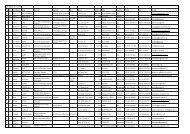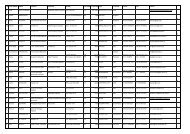icvg 2009 part I pp 1-131.pdf - Cornell University
icvg 2009 part I pp 1-131.pdf - Cornell University
icvg 2009 part I pp 1-131.pdf - Cornell University
Create successful ePaper yourself
Turn your PDF publications into a flip-book with our unique Google optimized e-Paper software.
— 17 —<br />
were found, in that a variant of group II was recovered from<br />
a non diseased cv. Shiraz vine (Goszczynski et al., 2008).<br />
The gene silencing su<strong>pp</strong>ressor encoded by GVA was<br />
identified in the 10 kDa protein expressed by the sequence<br />
of the 3’ terminal ORF of the viral genome. This protein<br />
binds single-stranded and double-stranded forms of small<br />
interfering RNAs and microRNAs. Thus its mechanism of<br />
action is based on sequestering of RNA, which is not made<br />
available for the RNA-induced silencing complex (RISC)<br />
(Zhou et al., 2006).<br />
GVA was successfully used as a vector for silencing<br />
the endogenous phytoene desaturase (PDS) gene in N.<br />
benthamiana, thus qualifying as an useful tool for virusinduced<br />
gene silencing experiments. In fact, using<br />
Agrobacterium-mediated inoculation of the vector through<br />
the roots of micropropagated plantlets of Vitis vinifera cv.<br />
Prime it was possible to obtain PDS silencing in grapevine<br />
(Muruganantham et al., <strong>2009</strong>).<br />
A GVA vector intended to be used as a<br />
biotechnologicl tool for grapevine improvement<br />
programmes, has also been developed. The vector, which<br />
contains the sequence of the movement protein promoter of<br />
a GVA isolate distantly related to the strain donor of the<br />
sequence, was successfully engineered and used for<br />
expressing foreign proteins (the reporter gene betaglucuronidase<br />
and the coat protein gene of Citrus tristeza<br />
virus) in N. benthamiana (Haviv et al. 2006).<br />
Foveaviruses. A new variant of GRSPaV (denoted<br />
GRSPaV-PN) was found in declining cv. Pinot noir vines<br />
grafted on 3309C, affected by pitting and stem necrosisdistortion<br />
in California and characterized molecularly. The<br />
genome of this strain (8,724 nucleotide in size) was<br />
completely sequenced and, when analysed in detail, its<br />
replicase gene was found to diverge widely (76% and 78%<br />
nucleotide and amino acid identity, respectively) from<br />
comparable sequences in database. Moreover, contrary to<br />
other records, it possessed a sixth ORF at the 3’ end, thus<br />
confirming what previously reported for other GRSPaV<br />
isolates for California. Whether GRSPaV-PN is involved in<br />
Pinot noir decline has not yet been established (Lima et al.,<br />
<strong>2009</strong>).<br />
Closteroviruses. For the first time full-length clones of<br />
a grapevine-infecting closterovirus (GLRaV-2) were<br />
synthesized and shown to be infectious to N. bentamiana<br />
following Agrobacterium-mediated infiltration. This opens<br />
the way to fine studies on virus-host interactions that<br />
underlie the viral replication cycle. These constructs were<br />
used to address the function of the tandem leader proteases<br />
L1 and L2 present in ORF 1 of the GLRaV genome. It was<br />
found that L1 is essential for virus ability to establish<br />
infection whereas L2 has a determining role in genome<br />
replication and an accessory role in viral systemic transport.<br />
When construct variants were agro-infiltrated in grapevine,<br />
deletion of either L1 or L2 resulted in a strong reduction of<br />
the ability to establish infection (Liu et al., <strong>2009</strong>).<br />
A Chinese isolate of GLRaV-2 was <strong>part</strong>ially<br />
sequenced and shown virtually identical (98% homology)<br />
to some of the previously sequenced isolates of the same<br />
virus (GLRaV-2-PN and GLRaV-2-Sem), but distinct (78%<br />
homology) from the divergent strain GLRaV-2-RG.<br />
New sequence variants of GLRaV-2 were found in<br />
different accessions cv. Waltham Cross from South Africa<br />
(Prosser et al., 2007), thus confirming the molecular<br />
heterogenity of this virus. Some of these variants had a<br />
stretch of 19 extra nucleotides in the 3’ untranslated region<br />
which occurs also in the strain GLRaV-2-RG from<br />
California but not in the strains denoted PN and 93/955 (see<br />
Martelli, 2006).<br />
Ampeloviruses. The genome af two new GLRaV-3<br />
isolates has been completely sequenced. One of these, from<br />
Chile, was virtually identical to GLRaV-3-NY1, with which<br />
it shared 98% nucleotide identity (Engel et al., 2008),<br />
whereas a South African isolate was distinctly different<br />
from both, having an unusually long (737 nt) 5’<br />
untranslated region and a previously unreported 82 nt<br />
overlap between ORF1a and ORF1b (Maree et al., 2008).<br />
One of three GLRaV-3 isolates from cv. Waltham Cross<br />
from South Africa had a HSP70 gene 93% identical to the<br />
comparable sequence of GLRaV-3-NY-1, However, the<br />
remaining two had an identity level of 72.3% (Prosser et<br />
al., 2007), which made the authors wondering whether they<br />
could represent a new and distinct species in the genus<br />
Ampelovirus.<br />
The extant species demarcation criteria set up by the<br />
International Committee on Taxonomy of Viruses for<br />
discriminating species in the genera of the family<br />
Closteroviridae, are: (i) <strong>part</strong>icle size; (ii) size of CP<br />
subunits as determined by deduced amino acid sequence<br />
data; (iii) serological specificity using discriminatory<br />
monoclonal or polyclonal antibodies; (iv) genome structure<br />
and organization (number and relative location of the<br />
ORFs); (v) magnitude and specificity of natural and<br />
experimental host range; (vi) amino acid sequence of<br />
relevant gene products (CP, CPm and HSP70h) differing by<br />
more than 10%; (vi) vector species and specificity; (vii)<br />
cytopathological features (i.e. aspect of inclusion bodies<br />
and origin of cytoplasmic vesicles) (Martelli et al., 2005). It<br />
so ha<strong>pp</strong>ened that, the more readily secured molecular<br />
information has lately prevailed as a taxonomic<br />
discriminant over biological information. It ensued that, in<br />
the absence of uncontroversial serological data, due to the<br />
inconsistent reactivity of some available reagents,<br />
molecular parameters were heavily relied upon as the single<br />
most prominent criterion for species identification. So, the<br />
narrow 10% boundary in sequence identity of ‘relevant<br />
genes’ was often broken, propitiating the proliferation of<br />
new putative species which, in the case of leafroll<br />
ampeloviruses have grown to nine. Recently, sequences of<br />
two additional GLRaVs were deposited in GenBank under<br />
the denomination of GLRaV-10 and GLRaV-11. Although<br />
these names were not in published reports, they seeped<br />
through the literature (e.g. Sether et al, <strong>2009</strong>), risking to<br />
become entrenched in it.<br />
Already in 2006, it was pointed out that “GLRaV-4, -<br />
5, -6 and -9 form a coherent phylogenetic cluster separate<br />
from those comprising other members of the genus<br />
Ampelovirus. Within this cluster, the identity at the amino<br />
acid level of the phylogenetically relevant HPS70 viral<br />
gene is below the 10% level (about 80 to 88%). Thus,<br />
additional comparative investigations are desirable for<br />
defining the taxonomic status of each member of this group<br />
of viruses, and identifying consentaneous criteria to serve<br />
Progrès Agricole et Viticole, <strong>2009</strong>, Hors Série – Extended abstracts 16 th Meeting of ICVG, Dijon, France, 31 Aug – 4 Sept <strong>2009</strong>




